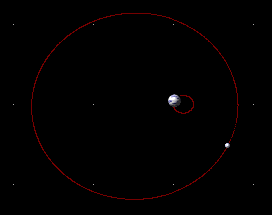 Gravitation
Gravitation
(Another in a series of experimental internet delivered
activities)
Lesson ©1994, 1998 by James
P. Riser
Click here to go to James
P. Riser's home pages.
Required software:

Gravitation 5.0b1 by Jeff Rommereide (Macintosh only)
can be downloaded from the internet.


About the software:
Gravitation is a simulation program that will allow
the user to experiment with hypothetical systems that might be
found in space. Masses, distances, directions of movement, velocities,
and numbers of objects may all be varied and visually observed
for interaction.
Note: After starting the program, be certain
to check out the Help and Info... under the Apple Menu to learn
about using the software. To examine or create the settings for
a system, select Solar System Editor from the Edit Menu.
Purpose of this activity:
This activity was designed so that my students (by
utilizing a powerful simulation program to design and experiment)
could better understand and appreciate factors affecting a system.
Necessary background information:
- Mass is a measurement of the amount of matter in an object.
- The more mass in an object, the stronger its gravitational
field.
- Gravitational attraction between two objects increases as
they get closer and decreases as they get farther apart.
- The orbiting velocity of an object can equal or even overcome
the gravitational attraction between two objects.
Your Assignment:
- Observation phase -
- Select at least six of the example files under File/Open.
- Run each example separately and examine the data (under Edit/Solar
System Editor) for each example.
- Write a full description of what is happening in each example.
Be sure to indicate which examples you are describing. Be complete
and use complete sentences.
- Experimental phase -
Using information given above and from your observations,
your mission is to design, run, and save simulations of any three
of the following:
1. Solar system with one sun and one orbiting planet (having
one orbiting moon).
2. Solar system having one sun and three planets.
3. Solar system having two suns- each sun has one orbiting
planet.
4. Solar system having one sun, one planet, and an approaching
asteroid which gets captured into orbit by the planet
(the asteroid becomes a moon).
5. Solar system having one sun and five planets.
6. Two objects approach each other, capture each other, and
orbit one another.
7. Solar system with one star, nine planets, and a total of
thirteen moons. All planets and moons must eventually fall into
the sun.
8. Solar system with one sun and two planets. One of the planets
has an orbiting moon which must be "taken" by the second
planet.
9. Your very own system - made to do what you want it to do.
- Evaluation phase -
1. Collect your written descriptions of the systems that you
examined before creating your own systems.
2. If you selected Experimental Phase number 9 above, write
a description of what your system illustrates. Attach this to
your other descriptions.
3. Write out a description of what a simulation is and how
it might be useful to scientists.
4. After completing this assignment, write out - in your own
words - your definition of a system.
5. Hand in steps 1 - 4 of this Evaluation phase and demonstrate
your saved simulations to your instructor.